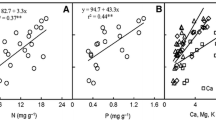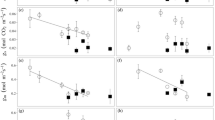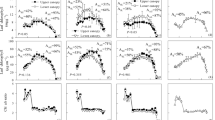Abstract
To determine which ecophysiological factors appear to control monoterpene concentrations in balsam fir foliage [Abies balsamea (L.) P. Mill.], the percentage of photosynthetically active radiation (%PAR), specific leaf area (SLA), light-saturated photosynthesis (A max), and concentrations per unit leaf area of foliar nitrogen (N), total soluble sugars (TSS), starch and monoterpenes were measured on current-year needles from three canopy levels (upper, middle and lower) the year following a pre-commercial thinning. The thinning only modestly changed the light profile within the canopy. %PAR was negatively correlated with SLA (r 2=0.62 in June, r 2=0.53 in July and August) and positively correlated with foliar nitrogen concentrations (r 2=0.51) within the crown profile. The positive relationship between N and A max was quite weak (r 2=0.15), suggesting significant variations in non-photosynthetic N within the canopies. Total monoterpenes were positively correlated with both %PAR (r 2=0.29) and A max (r 2=0.27), and negatively correlated with SLA (r 2=0.30). Contrary to that predicted by the carbon-nutrient balance hypothesis, total monoterpenes were negatively and only very weakly correlated with the starch/N ratio (r 2=0.06) and were not significantly correlated with either the TSS/N or the [TSS+starch]/N ratios. Monoterpenes were positively correlated with both N and TSS, although the relationship varied with the phenological state of the foliage, i.e., monoterpenes were more highly correlated with TSS (r 2=0.67) (immature foliage) in June, and in July and August with N (r 2=0.63) (mature foliage). Thus, it appears that monoterpene concentrations may be controlled primarily by carbohydrate supply in the early growing season and later by enzymatic capacity. Data expressed on a dry weight basis showed a similar pattern.
Similar content being viewed by others
Author information
Authors and Affiliations
Additional information
Received: 29 July 1999 / Accepted: 2 March 2000
Rights and permissions
About this article
Cite this article
Lamontagne, M., Margolis, H. & Bauce, É. Testing the ecophysiological basis for the control of monoterpene concentrations along canopy profiles in thinned and unthinned balsam fir stands. Oecologia 124, 318–331 (2000). https://doi.org/10.1007/s004420000393
Issue Date:
DOI: https://doi.org/10.1007/s004420000393




